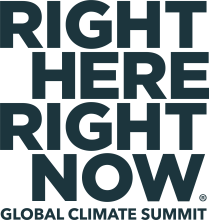Without question, humanity has accelerated climate change. The change is detrimental and often disproportionately affects the most vulnerable among us, including our youngest generation, impoverished people, people with disabilities, and Indigenous and island peoples.
But there is good news–right here, right now, the solutions are within us.
United Nations Human Rights, CU Boulder and the Right Here, Right Now Global Climate Alliance are co-hosting a three day global climate summit addressing human rights and climate change, as together we explore solutions that every sector of society–government, business, education and individuals–can adopt and act upon.
- Advance education about climate change as a human rights crisis.
- Discuss the responsibilities and obligations of various entities to address crises
- Identify actionable solutions that are grounded in respect for human rights
The Right Here Right Now Global Climate Summit (RHRN) focuses on the human rights impacts and challenges created by climate change as well as the need for human-focused solutions. For further background on the conference and a human rights-centered perspective, please review this article: “How a human rights approach to climate change can spark real change.”
The RHRN Educator’s Guide strives to support educators working to connect formal and informal learning spaces to the conference content. The guide is divided into three sections to match the three conference themes: Impacts, Obligations, and Solutions, and includes educational materials focused on climate science and understanding earth systems through a human rights lens.
The Educator’s guide complements the conference resources developed for each theme:
Impacts: Understanding the Vulnerabilities of Climate Change
Lessons and Links
Climate Change: Who Creates It? Who Feels It? (Link to Google Doc)
Created by: Jonas Smead, Elizabeth Gordon (Stober Elementary School)
In this lesson, students will play a game to consider the disparity between climate change causes and impacts. The game will be followed by a short presentation by the teacher and a class discussion.
- Driving Question: Who is responsible for climate change and which groups and communities most feel its effects?
- Grade Level: Elementary school
- Instructional Time: One class period (50 min.)
Climate Change & Human Health (Link to Google Doc)
Created by: Caley Gallison (Horizons K-8 School)
In this lesson, students will research the connection between climate change and health by researching how different body systems are connected to environments and ecosystems. The accompanying slideshow will guide students through this research and lesson time can be adjusted based on depth of the research.
- Driving Question: How are climate change and human health connected?
- Grade Level: Middle School
- Instructional Time:1-2 60 minute class periods (depending on student background)
Living with Drought (Link to Google Doc)
Created by: Peter Szameitat (Fairview High School) and Patrick Chandler (CIRES)
In this lesson, students will play two rounds of Scattergories to consider individual and systemic impacts of drought and will then work through a drought mitigation activity that offers multiple levels of action for students, schools, and communities.
- Driving Question: How do we experience and mitigate the impacts of drought?
- Grade Level: Middle/High School
- Instructional Time: 60 minutes
Learning from the Dakota Access Pipeline Protests (Link to Google Doc)
Created by: Martha Alvarez (Palmer High School) and Patrick Chandler (CIRES)
Many students will remember the Dakota Access Pipeline protests. This lesson will guide them to consider the evolution of the movement, who was involved, and what was at stake. The lesson can also serve as a template for investigating other environmental movements.
- Driving Question: What can we learn about environmental movements from the Dakota Access Pipeline protests?
- Grade Level: Middle/High School
- Instructional Time: 60 min. (one class period)
Modeling Climate Change with Temperature (Link to Google Doc)
Created by: Cooper Anstett (CU Teach program)
There are many ways to identify climate change, including CO2 levels, temperature, and deforestation, among other “variables.” In this lesson, we focus specifically on how temperature and CO2. Students will learn how to model climate change using multiple models, both physical and digital.
- Driving Question: What does a “1.5 degree” earth mean? (How do we identify climate change?)
- Grade Level: Middle/High School
- Instructional Time: 60 minutes (total time needed)
Designing Resilience (Link to Google Doc)
Created by: Patrick Chandler (CIRES)
This teacher’s guide will feature materials from the Educator’s Guide to the Right Here, Right Now Global Climate Summit. It focuses on the “Impacts” theme and the Cities, Settlements and Community Infrastructure category. First, students will work through a climate and resilient cities lesson. Then they will read about hurricane impacts in the Caribbean and complete the lesson by considering the risks and steps to resiliency in their communities.
- Driving Question: What does it mean to design a climate-resilient city amid uncertainty?
- Grade Level: Middle/High School
- Instructional Time: Two to four class periods depending on grade level, take-home work, and depth of lessons. (1.5-3.5 hrs.)
Indigenous peoples and climate change (Link to Google Doc)
Created by: Kristen Mcdermott (Centaurus High School) and Patrick Chandler (CIRES)
In this lesson, students will learn more about native peoples in their region, what climate change means to different indigenous groups, and how to support native groups.
- Driving Question: How can we support indigenous peoples, who are often frontline communities, during climate change?
- Grade Level: Middle/High School
- Instructional Time: 60 min.
Gender Equity in STEM Education (Link to Google Doc)
Created by: Collette Heskett (CU Teach program)
In this lesson, students will discuss and learn about two phenomena: First, students will learn about programs and people that have dedicated their time to making the STEM field a more equitable place for all genders. Second, students will discuss how this idea of gender equity in STEM education will stabilize/decrease climate change and increase human rights globally.
- Driving Question: What might happen to climate change if more genders were represented in STEM?
- Grade Level: High School
- Instructional Time: 50 minutes
Climate Action through Youth Activism and Women's Rights
In this pre-summit event, experts will discuss how to support women and youth in climate action. Without question, humanity has accelerated climate change. The change is detrimental and often disproportionately affects the most vulnerable. But there is good news–right here, right now, the solutions are within us. United Nations Human Rights, CU Boulder, and the Right Here, Right Now Global Climate Alliance are co-hosting a three-day global climate summit addressing human rights and climate change, as together we explore solutions that every sector of society–government, business, education, and individuals–can adopt and act upon.
Speakers:
Monica Neupane, President at CliMates Nepal
Madhvi Chittoor, aka NoStyrofoam Ninja, is the youngest UN Child Advisor at 11 years old.
Stephanie Lamma Ewi, The UN Agora Award winner
Hilda Flavia Nakabuye, Fridays for Future Uganda
Sarah Fahmy, University of Colorado at Boulder (moderator)
For more information on our speakers, please visit the CIRES webinar page.






